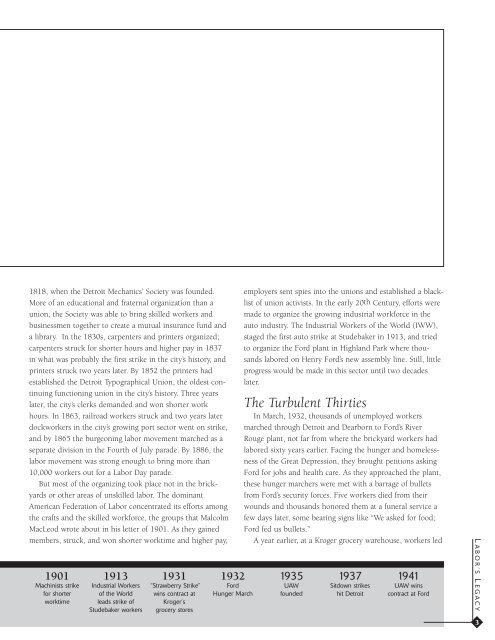LABOR’S LEGACY
1FllZUG
1FllZUG
- No tags were found...
You also want an ePaper? Increase the reach of your titles
YUMPU automatically turns print PDFs into web optimized ePapers that Google loves.
1818, when the Detroit Mechanics’ Society was founded.<br />
More of an educational and fraternal organization than a<br />
union, the Society was able to bring skilled workers and<br />
businessmen together to create a mutual insurance fund and<br />
a library. In the 1830s, carpenters and printers organized;<br />
carpenters struck for shorter hours and higher pay in 1837<br />
in what was probably the first strike in the city’s history, and<br />
printers struck two years later. By 1852 the printers had<br />
established the Detroit Typographical Union, the oldest continuing<br />
functioning union in the city’s history. Three years<br />
later, the city’s clerks demanded and won shorter work<br />
hours. In 1863, railroad workers struck and two years later<br />
dockworkers in the city’s growing port sector went on strike,<br />
and by 1865 the burgeoning labor movement marched as a<br />
separate division in the Fourth of July parade. By 1886, the<br />
labor movement was strong enough to bring more than<br />
10,000 workers out for a Labor Day parade.<br />
But most of the organizing took place not in the brickyards<br />
or other areas of unskilled labor. The dominant<br />
American Federation of Labor concentrated its efforts among<br />
the crafts and the skilled workforce, the groups that Malcolm<br />
MacLeod wrote about in his letter of 1901. As they gained<br />
members, struck, and won shorter worktime and higher pay,<br />
1901<br />
Machinists strike<br />
for shorter<br />
worktime<br />
1913<br />
Industrial Workers<br />
of the World<br />
leads strike of<br />
Studebaker workers<br />
1931<br />
“Strawberry Strike”<br />
wins contract at<br />
Kroger’s<br />
grocery stores<br />
1932<br />
Ford<br />
Hunger March<br />
employers sent spies into the unions and established a blacklist<br />
of union activists. In the early 20th Century, efforts were<br />
made to organize the growing industrial workforce in the<br />
auto industry. The Industrial Workers of the World (IWW),<br />
staged the first auto strike at Studebaker in 1913, and tried<br />
to organize the Ford plant in Highland Park where thousands<br />
labored on Henry Ford’s new assembly line. Still, little<br />
progress would be made in this sector until two decades<br />
later.<br />
The Turbulent Thirties<br />
In March, 1932, thousands of unemployed workers<br />
marched through Detroit and Dearborn to Ford’s River<br />
Rouge plant, not far from where the brickyard workers had<br />
labored sixty years earlier. Facing the hunger and homelessness<br />
of the Great Depression, they brought petitions asking<br />
Ford for jobs and health care. As they approached the plant,<br />
these hunger marchers were met with a barrage of bullets<br />
from Ford’s security forces. Five workers died from their<br />
wounds and thousands honored them at a funeral service a<br />
few days later, some bearing signs like “We asked for food;<br />
Ford fed us bullets.”<br />
A year earlier, at a Kroger grocery warehouse, workers led<br />
1935<br />
UAW<br />
founded<br />
1937<br />
Sitdown strikes<br />
hit Detroit<br />
1941<br />
UAW wins<br />
contract at Ford<br />
L ABO R’S L E GACY<br />
3


